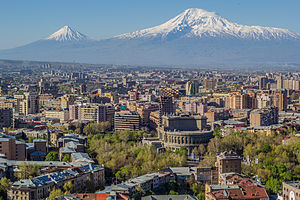
Orange: areas overwhelmingly populated by Armenians (Republic of Armenia: 98%;[3] Javakheti: 95%[4]).
Yellow: Historically Armenian areas with presently no or insignificant Armenian population (Western Armenia, Nakhchivan and recently Nagorno-Karabakh).
Note: Artsakh (Nagorno-Karabakh) is shown in pre-2020 de facto borders.

United Armenia (Armenian: Միացեալ Հայաստան, romanized: Miats'eal Hayastan),[b] also known as Greater Armenia or Great Armenia, is an Armenian ethno-nationalist irredentist concept referring to areas within the traditional Armenian homeland—the Armenian Highland—which are currently or have historically been mostly populated by Armenians. The idea of what Armenians see as unification of their historical lands was prevalent throughout the 20th century and has been advocated by individuals, various organizations and institutions, including the nationalist parties Armenian Revolutionary Federation (ARF or Dashnaktsutyun) and Heritage, the ASALA and others.
The ARF idea of "United Armenia" incorporates claims to Western Armenia (eastern Turkey), Nagorno-Karabakh (Artsakh), the landlocked exclave Nakhchivan (Nakhichevan) of Azerbaijan and the Javakheti (Javakhk) region of Georgia.[1][2] Javakhk is overwhelmingly inhabited by Armenians. Western Armenia and Nakhchivan had significant Armenian populations until the early 20th century, and Nagorno-Karabakh until 2023, but no longer do. The Armenian population of Western Armenia was almost completely exterminated during the 1915 Armenian genocide, when the millennia-long Armenian presence in this region largely ended and Armenian cultural heritage was mainly destroyed by the Ottoman government.[8][9] In 1919, the ARF-dominated government of the First Republic of Armenia declared the formal unification of Armenian lands. The ARF bases its claims to Western Armenia, now controlled by Turkey, on the 1920 Treaty of Sèvres, which was effectively negated by subsequent historical events. These territorial claims are often seen as the ultimate goal of the recognition of the Armenian Genocide and as part of Armenian genocide reparations.[10][11]
The most recent Armenian irredentist movement, the Karabakh movement which began in 1988, sought to unify Nagorno-Karabakh with then-Soviet Armenia. As a result of the subsequent war with Azerbaijan, Armenian forces established effective control over most of Nagorno-Karabakh and the surrounding districts, thus succeeding in the de facto unification of Armenia and Karabakh.[12][13] Some Armenian nationalists consider Nagorno-Karabakh "the first stage of a United Armenia."[14]
- ^ a b Cite error: The named reference
crisisgroupwas invoked but never defined (see the help page). - ^ a b Cite error: The named reference
FOOTNOTEHarutyunyan200989was invoked but never defined (see the help page). - ^ "2011 Census Results" (PDF). armstat.am. National Statistical Service of Republic of Armenia. p. 144.
- ^ Cite error: The named reference
geostatwas invoked but never defined (see the help page). - ^ Shirinian, Lorne (1992). The Republic of Armenia and the rethinking of the North-American Diaspora in literature. Edwin Mellen Press. p. 78. ISBN 978-0773496132.
- ^ Adriaans, Rik (2011). "Sonorous Borders: National Cosmology & the Mediation of Collective Memory in Armenian Ethnopop Music". University of Amsterdam. p. 48. Archived from the original on 5 March 2016.
{{cite web}}: CS1 maint: unfit URL (link) - ^ Khojoyan, Sara (1 August 2008). "Beyond and Inside: Turk look on Ararat with Armenian perception". ArmeniaNow. Archived from the original on 17 November 2015.
- ^ Hovannisian, Richard G. (2008). The Armenian Genocide: Cultural and Ethical Legacies. New Brunswick, NJ: Transaction Publishers. p. 22. ISBN 978-1-4128-3592-3.
- ^ Jones, Adam (2013). Genocide: A Comprehensive Introduction. Routledge. p. 114. ISBN 978-1-134-25981-6.
- ^ Theriault, Henry (6 May 2010). "The Global Reparations Movement and Meaningful Resolution of the Armenian Genocide". The Armenian Weekly. Archived from the original on 10 May 2010.
- ^ Stepanyan, S. (2012). "Հայոց ցեղասպանության ճանաչումից ու դատապարտումից մինչև Հայկական հարցի արդարացի լուծում [From the Recognition and Condemnation of the Armenian Genocide to the Just Resolution of the Armenian Question]". Lraber Hasarakakan Gitutyunneri (in Armenian) (1). Yerevan: Armenian Academy of Sciences: 34. ISSN 0320-8117. Archived from the original on 10 November 2017. Retrieved 26 September 2014.
Արդի ժամանակներում Հայկական հարցը իր էությամբ նպատակամղված է Թուրքիայի կողմից արևմտահայության բնօրրան, ցեղասպանության և տեղահանության ենթարկված Արևմտյան Հայաստանը' հայրենիքը կորցրած հայերի ժառանգներին և Հայաստանի Հանրապետությանը վերադարձնելուն:
- ^ Ambrosio 2001, p. 146: "... Armenia's successful irredentist project in the Nagorno-Karabakh region of Azerbaijan."
- ^ Hughes, James (2002). Ethnicity and Territory in the Former Soviet Union: Regions in Conflict. London: Cass. p. 211. ISBN 978-0-7146-8210-5.
Indeed, Nagorno-Karabakh is de facto part of Armenia.
- ^ "ARS Marks Centennial With Pilgrimage to Der Zor, Armenia and Karabakh". Asbarez. 30 December 2010. Archived from the original on 25 July 2021.
...Artsakh, the guiding light of Armenian victories and the first stage of a United Armenia.
Cite error: There are <ref group=lower-alpha> tags or {{efn}} templates on this page, but the references will not show without a {{reflist|group=lower-alpha}} template or {{notelist}} template (see the help page).